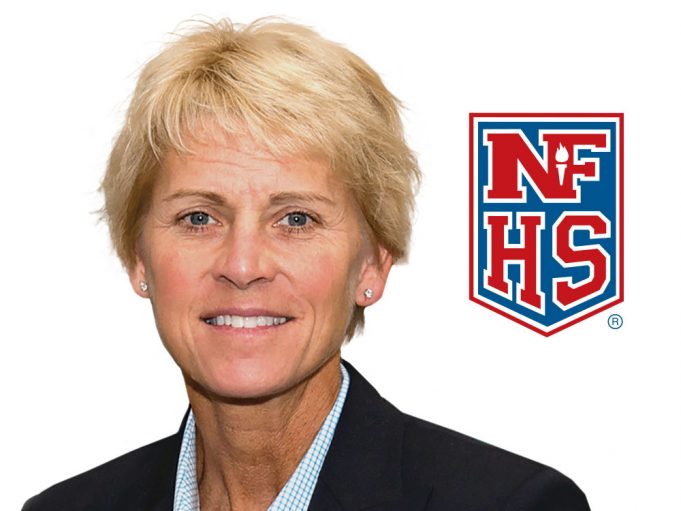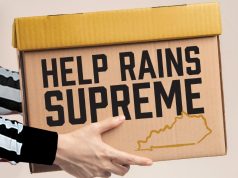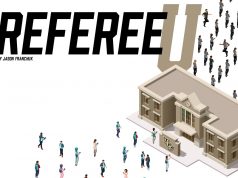Dr. Karissa Niehoff needed no prompting to address the elephant in the room.
“We’re definitely supportive of the great work that our officials are doing, and we’re also really aware of the critical mass issue that we’re facing,” said Niehoff, the new executive director of the NFHS, during an opening exchange of pleasantries.
Below are some of the highlights of our 30-minute conversation, in which Niehoff — who in August became the first female to lead the NFHS — addresses how her time as executive director of the Connecticut Association of Schools-Connecticut Interscholastic Athletic Conference (CAS-CIAC) has prepared her to work with officials at the NFHS level, and what must be done to bring and keep more officials in the NFHS fold.
Have you ever officiated, and if so, what was your experience?
I have never been an official that would have the black-and-white stripes on. Certainly as a coach you’re in a position where you’re officiating scrimmage play. I’ve officiated some scrimmages for things, but I’ve never worked in the capacity of a trained official.
Since you haven’t officiated, how do you get up to speed with how the NFHS works hand-in-hand with officials?
Really, just having been in a state association position, we had a terrific relationship. Our officials association was actually in our office building, so for the last eight years working at a state level, I was really getting to know the business of the NFHS and the role of the officials’ efforts within NFHS, and the importance of how the officials’ world functioned from state-to-state relationships, even with Arbiter and things like that. In the last eight years in particular, I’ve gotten to learn how the NFHS works with (the officiating) world.
You have an extensive background on the coaching side of high school sports. What would you say was your reputation with officials when you were a field hockey coach?
I think my reputation with the officials was very good. I was very intentional about paying attention to my own modeling for the players, for the fans. I was very clear in my communications with players and fans and colleagues within the school community, that the officials were another team on the field and were doing their job and they deserve respect. I modeled that. It doesn’t mean that I was afraid to ask them a question if I disagreed or had a question about a call, but if I did so, which was rare, it was either at a naturally scheduled break, or a whistle, or something like that, so I could explain to the kids this was their perspective on something. They saw positive communication. As an athletic director, as a school principal, I enforced positive behavior in the fans, players, and always made sure that officials had what they needed, and that they were thanked, and that they were paid on time. I made sure that their experience with our players, with me as a coach, with our school, was a positive, and that they would come back again if they had the opportunity.
One of the biggest challenges in the world of officiating is how we get people interested in officiating and staying with it. What do you see as the NFHS role in officiating, particularly in the areas of recruiting and retention?
I can tell you that it is one of our biggest priorities right now. There is a critical mass issue, even in sports where you think there never would be. We’re hearing from state associations that they’ve had to move football games to Thursday nights in some cases just so they can field their crew for Fridays and Saturdays. We recognize that the scheduling of games is becoming a challenge now in many sports.
In the last year in particular, we’ve embarked on formal initiatives, recruitment campaigns, and we’ve invested significant dollars in establishing these campaigns. We are seeing some return on investment, but certainly not the level of return that we’re hoping for. We’re working with state associations to encourage them to initiate programs to attract new candidates. We’re seeing some states looking at folks returning from the military, or in human services where they may have flexible schedules. So we’re really trying to partner with organizations, with our states, and invest our time and effort, messaging and money in creating campaigns to recruit and retain officials in all sports.
How do you improve recruiting and retention of more women and minorities into officiating?
We have to go out to places where we can identify potential candidates, physically introduce ourselves to them, engage them in opportunities to try out the whistle, and then we need to support them. We need to make sure the experience is positive, we need to provide mentorship and support better than we do now, and I think we have to work with our current officials associations in a positive way to say, “You’re our boots on the ground out there, we need you to go out and find them and give them the experience.”
I know in some places we hear reports where assigners, for example, go back to the well for the same people. The same folks have done state tournaments for 20 years. We’ve got to grow the people and give them opportunity so that they stay in the profession, and when they’re ready, they can have a tournament game.
So we need to change the culture a little bit. We certainly need to go out and find them, and keep them. And we need to market this, we need to promote the faces of the minority candidates engaged in the profession already, and get them out in front of people, and have them out there telling their stories.
You’ve been a member of an NFHS rules committee, so you’ve seen the rulesmaking process from that side. What have you been able to glean from such a role when it comes to relationships between rulesmaking at the NFHS level and the officials?
The perspective of the official is critical to how rules are developed, the content, how they’re written, and the language, based on an interpretation issue. If (officials) can really add a voice, their perspective, it provides us insight with how well a rules manual can be interpreted with consistency, understood with consistency, implemented with consistency, and how the relationship then between coaches and teams and officials during a contest can be smooth, based on how well we understand the rules. It all goes right back into that committee room when we’re thinking about changes to rules. We absolutely have to have (the officials’) perspective.
How do we make sports officiating a better experience at the high school level?
Some of the things that we’ve heard from officials groups are that we’ve got to make sure that the environment in which an official is working is a positive one. There are a lot of elements to that environment. First and foremost you’ve got to have your contest scheduled, and if they show up somewhere they’re at the right place. We’ve got to make sure that our schedules are developed with integrity and good thought, and certainly that the information sharing with officials is accurate and timely. Secondly, obviously if they arrive at a contest they know where they’re going. They’ve got the appropriate facility in which to change or work with their colleagues. Perhaps there’s some refreshments there, there’s some hospitality. The site coordinator is there, they’re introduced to the coaches, anything that they would need in terms of implementing their job in the contest is there, equipment is intact. So all of those elements to run an event. And then during the contest itself, the first and most important priority is that the coaches and players are there, the coaches and players are positive, their behavior, their interaction with the officials is positive, and right after that comes the fans. We’ve got to have fans demonstrating positive behavior, and that means that schools have to have rules in place, clearly communicated sportsmanship expectations, and the school staff at the contest to support and uphold the rules and make that environment for the officials a positive one.
What's Your Call? Leave a Comment:
Note: This article is archival in nature. Rules, interpretations, mechanics, philosophies and other information may or may not be correct for the current year.
This article is the copyright of ©Referee Enterprises, Inc., and may not be republished in whole or in part online, in print or in any capacity without expressed written permission from Referee. The article is made available for educational use by individuals.
















